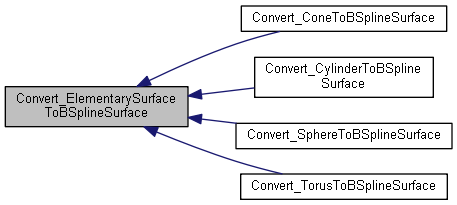Root class for algorithms which convert an elementary surface (cylinder, cone, sphere or torus) into a BSpline surface (CylinderToBSplineSurface, ConeToBSplineSurface, SphereToBSplineSurface, TorusToBSplineSurface). These algorithms all work on elementary surfaces from the gp package and compute all the data needed to construct a BSpline surface equivalent to the cylinder, cone, sphere or torus. This data consists of the following:
More...
#include <Convert_ElementarySurfaceToBSplineSurface.hxx>
Root class for algorithms which convert an elementary surface (cylinder, cone, sphere or torus) into a BSpline surface (CylinderToBSplineSurface, ConeToBSplineSurface, SphereToBSplineSurface, TorusToBSplineSurface). These algorithms all work on elementary surfaces from the gp package and compute all the data needed to construct a BSpline surface equivalent to the cylinder, cone, sphere or torus. This data consists of the following:
- degrees in the u and v parametric directions,
- periodic characteristics in the u and v parametric directions,
- a poles table with associated weights,
- a knots table (for the u and v parametric directions) with associated multiplicities. The abstract class ElementarySurfaceToBSplineSurface provides a framework for storing and consulting this computed data. This data may then be used to construct a Geom_BSplineSurface surface, for example. All those classes define algorithmes to convert an ElementarySurface into a B-spline surface. This abstract class implements the methods to get the geometric representation of the B-spline surface. The B-spline representation is computed at the creation time in the sub classes. The B-spline surface is defined with its degree in the parametric U and V directions, its control points (Poles), its weights, its knots and their multiplicity. KeyWords : Convert, ElementarySurface, BSplineSurface.
◆ Convert_ElementarySurfaceToBSplineSurface()
◆ IsUPeriodic()
| Standard_Boolean Convert_ElementarySurfaceToBSplineSurface::IsUPeriodic |
( |
| ) |
const |
◆ IsVPeriodic()
| Standard_Boolean Convert_ElementarySurfaceToBSplineSurface::IsVPeriodic |
( |
| ) |
const |
Returns true if the BSpline surface whose data is computed in this framework is periodic in the u or v parametric direction.
◆ NbUKnots()
◆ NbUPoles()
◆ NbVKnots()
Returns the number of knots for the u or v parametric direction of the BSpline surface whose data is computed in this framework .
◆ NbVPoles()
Returns the number of poles for the u or v parametric direction of the BSpline surface whose data is computed in this framework.
◆ Pole()
Returns the pole of index (UIndex,VIndex) to the poles table of the BSpline surface whose data is computed in this framework. Exceptions Standard_OutOfRange if, for the BSpline surface whose data is computed in this framework:
- UIndex is outside the bounds of the poles table in the u parametric direction, or
- VIndex is outside the bounds of the poles table in the v parametric direction.
◆ UDegree()
◆ UKnot()
Returns the U-knot of range UIndex. Raised if UIndex < 1 or UIndex > NbUKnots.
◆ UMultiplicity()
Returns the multiplicity of the U-knot of range UIndex. Raised if UIndex < 1 or UIndex > NbUKnots.
◆ VDegree()
Returns the degree for the u or v parametric direction of the BSpline surface whose data is computed in this framework.
◆ VKnot()
Returns the V-knot of range VIndex. Raised if VIndex < 1 or VIndex > NbVKnots.
◆ VMultiplicity()
Returns the multiplicity of the V-knot of range VIndex. Raised if VIndex < 1 or VIndex > NbVKnots.
◆ Weight()
Returns the weight of the pole of index (UIndex,VIndex) to the poles table of the BSpline surface whose data is computed in this framework. Exceptions Standard_OutOfRange if, for the BSpline surface whose data is computed in this framework:
- UIndex is outside the bounds of the poles table in the u parametric direction, or
- VIndex is outside the bounds of the poles table in the v parametric direction.
◆ isuperiodic
◆ isvperiodic
◆ nbUKnots
◆ nbUPoles
◆ nbVKnots
◆ nbVPoles
◆ poles
◆ udegree
◆ uknots
◆ umults
◆ vdegree
◆ vknots
◆ vmults
◆ weights
The documentation for this class was generated from the following file:

 1.8.13
1.8.13